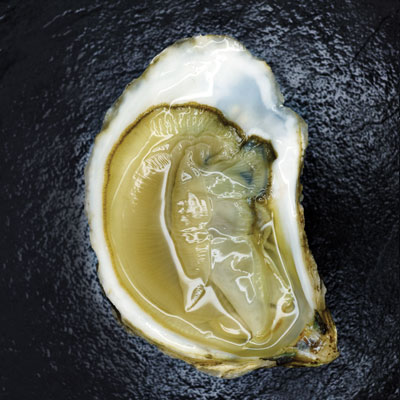Oyster lust: A boatload of varieties is within reach of St. Louis
The words “squishy” and “slimy,” common in oyster-speak, rarely stimulate the appetite. But thanks to FedEx and a mentality that oysters aren’t only for the wealthy anymore, Americans eat 2.5 billion oysters per year, according to the Molluscan Shellfish Institute. For the diner, fresh oysters are interactive. And for the chef, oysters offer the opportunity to take a meal from life to entrée with the stroke of a blunt shucker. It’s a rush, it’s fresh and it’s also a little dangerous. (Wrap the oyster in a towel to prevent cutting your palms while shucking.) In general, American oysters come in three broad classifications: Atlantic, Olympia and Pacific. For connoisseurs, the Atlantic has long been the go-to oyster of choice. A few decades ago, this meant a fervent search for an Atlantic variety known as the Blue Point, named after the region of Long Island where it was originally harvested. According to Phil Nekic, manager at Bob’s Seafood in University City, the Blue Point still reigns supreme in St. Louis. A larger oyster, the Blue Point ranges from 3 to 4 inches in diameter and sometimes requires a knife and fork to navigate. It also has a salty (see “briny” in oyster-speak) flavor with a melon-tinted aftertaste and, according to Nekic, is easier to shuck and therefore better for consuming raw. John Johnson, owner of Broadway Oyster Bar, concurred. About 60 percent of the oysters at his downtown Cajun-Creole restaurant are East Coasters, and on a good Saturday night, 1,000 of them hit the dining room. For a beginner, a tray of fresh oysters can be daunting. Jon Lowe, executive chef at Océano Bistro in Clayton, advised first-timers to just delve in. Order them on the half shell or even shuck a dozen at home if you’re feeling adventurous. However, for those who prefer to walk before they run, Johnson recommended trying oysters in a cooked dish such as Oysters Rockefeller or Bienville. (See accompanying recipe.) When cooked, an oyster’s texture firms up and the taste and smell become milder. See also Johnson’s grilled oysters. Shucked and thrown on the grill with a drizzling of garlic butter, they have the texture of fish and combine the sweetness of garlic with a chargrilled outer shell. In a word, Johnson said, “heaven.” Native to the Pacific Northwest, Olympia oysters are also popular in St. Louis. Almost opposite its East Coast counterpart, the Olympia is a very small oyster that rarely exceeds 2 inches and often has meat the size of a quarter. However, don’t let its humble size fool you. It packs an assertive, salty flavor, leaving a strong metallic aftertaste in its wake. Lowe noted that the difference in East Coast versus West Coast is often realized in the accompaniments. While Atlantic oysters tend to work well with tomatoes, Olympias can stand up to the acidity of a vinaigrette. Though Olympias were once almost extinct because of pollution and overfishing, they’re now grown commercially. “My customers sometimes get tired of tasting Blue Points,” Lowe said. “I use West Coast oysters to spice up my menu.” But note that spice comes at a higher price. Olympia oysters are considered gourmet options and often cost at least 30 percent more than their East Coast brethren. Bob’s Seafood also offers Virginicas for those looking to go bicoastal with their cuisine. Originally an East Coast strain, these oysters were transported to the Totten Inlet off the coast of Washington state and work well in cooked oyster dishes. Though Atlantic and Olympia options dominate the St. Louis oyster market, Pacific oysters make seasonal cameos. Sweeter, plumper and less salty than East Coasters, Pacific oysters are favored by budding oyster-eaters and anti-traditionalists alike. Pacifics also offer cucumber, melon and mineral undertones. The salty and metallic Kumamoto variety is native to Japan, although its relatively slow growth cycle contributed to a lack of commercial viability there. The tiny oysters, prized for their sweet taste and buttery texture, are now commercially farmed along the American West Coast. European Belons similarly are available at Bob’s Seafood beginning in February until around the end of November. A large flat oyster, 3 to 4 inches across, Belons command a premium price and, according to Nekic, better serve as a cooking oyster, unless metallic to the point of stainless steel is your flavor of choice. Despite geographical constraints, St. Louis purveyors can receive fresh oysters as fast as they can turn them. So don’t shy away in this, the month of love, from indulging in these alleged aphrodisiacs; raw oysters in particular pair nicely with a bottle of dry white wine or a blonde ale. And the first weekend in March, The Schlafly Tap Room will host its annual Stout & Oyster Festival, featuring 25,000 oysters, a shucking competition and the stouts to match – just in case the oysters alone don’t set the mood.Related Recipes
Most Recent
The Vandy, STL Barkeep team will open Off Elm in Webster Groves this fall
The cocktail wizards behind The Vandy will soon have another locus for …







